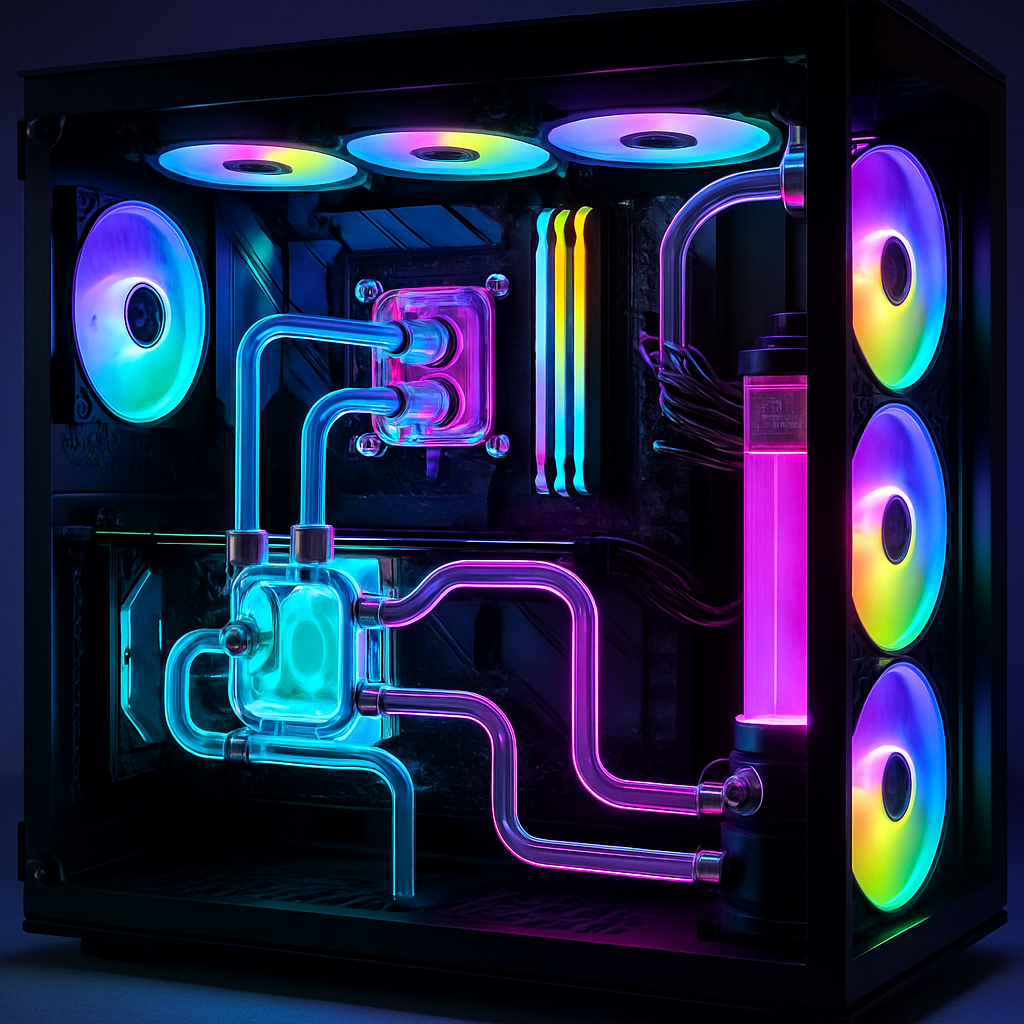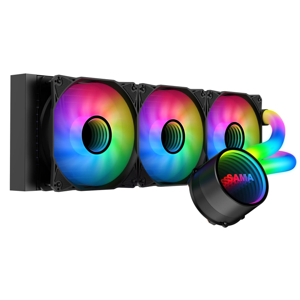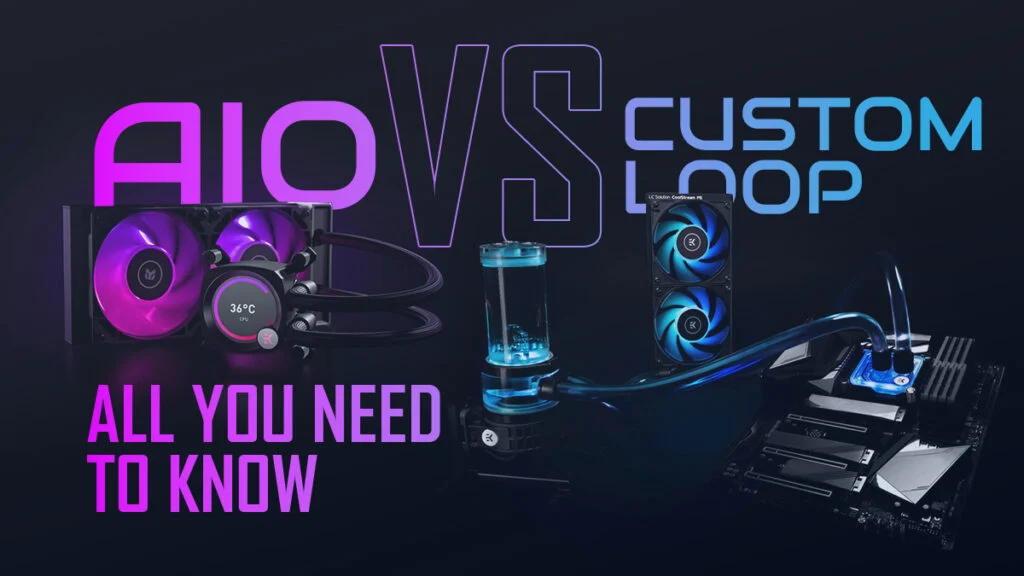1.What is a Custom Loop?
Custom Loop Water Cooling: The Ultimate Guide for Building a Cooler, Sleeker PC
Tame the heat, silence the noise, and build a PC that looks as cool as it runs.
Does your high-performance PC sound like a jet engine or run uncomfortably hot? Maybe you want your system to stand out with dazzling pipes and glowing liquid. If you’re nodding “yes,” then custom loop water cooling could be your ultimate PC upgrade!
In this comprehensive guide, I’ll walk you through what a custom loop is, why it’s awesome, what you need, and how to build one—step by step.
Why Should You Care About Custom Loop Water Cooling?
- Serious Cooling Power: Tame even the most demanding CPUs and GPUs.
- Low Noise: More efficient cooling = slower, quieter fans.
- Personalized Style: Your tubing, your coolant, your aesthetic.
- Upgrade Ready: Add GPUs, RAM, or VRMs later without rebuilding from scratch.
Imagine peering into your PC to see crystal-clear tubing, vibrant fluids, and subtle RGB lighting. It’s functional art.
What Exactly is a Custom Loop?

A custom loop is a hand-assembled cooling system using individual parts—unlike All-in-One (AIO) coolers that are sealed and prebuilt.
It gives you full control over:
- What gets cooled (CPU, GPU, RAM, VRMs, etc.)
- How it looks (from minimal to insane)
- How efficiently it performs under pressure
Components of a Custom Loop (And What Each One Does)
- 💠 Water Blocks:
• CPU block: Transfers heat from your processor.
• GPU block: Cools your graphics card directly. - 🌬️ Radiators:
Dissipate heat via airflow. Sizes range from 120mm to 480mm. Bigger = better cooling. - ⚙️ Pump & Reservoir:
Pump circulates coolant; reservoir holds excess fluid and helps remove air bubbles. - 🔗 Tubing & Fittings:
Tubing connects everything; fittings secure and seal those connections. - 🧪 Coolant:
Heat transfer liquid that’s available in clear, colored, or glowing UV styles.
Step-by-Step Guide: Building Your Custom Loop
- Plan Your Loop: Identify what to cool, check case size, and sketch your layout.
- Select Your Gear: Get compatible blocks, radiators, fittings, and pump/res combo. Beginners? Try a kit!
- Prepare Your Workspace: Clean area + tools (screwdrivers, heat gun, cutters, etc.).
- Dry Fit: Install components without coolant. Plan the tubing run visually.
- Install Tubing & Fittings: Cut/bend tubing. Use the right fittings for leak-proof assembly.
- Leak Test: Power only the pump, add coolant, and check for leaks for at least 30 minutes.
- Final Assembly: Finish wiring, install remaining parts, and enjoy the results.
Pros and Cons at a Glance
| Pros | Cons |
|---|---|
| Superior cooling | More expensive than air coolers |
| Quieter operation | Requires technical know-how |
| Amazing visual appeal | Needs periodic maintenance |
| Fully customizable | Mistakes can cause leaks |
Tips for Success (From Seasoned Loop Builders)
- Start simple—cool just the CPU with soft tubing.
- Buy extra fittings and tubing—you’ll thank yourself.
- Use quality coolant—avoids build-up and corrosion.
- Don’t mix metals—stick to copper, nickel, or brass only.
- Plan a drain valve—it makes maintenance way easier.
- Document your build—it’s both helpful and fun.
Frequently Asked Questions (FAQ)
- Is custom water cooling better than air?
Yes—especially for high-performance or overclocked builds. - How often do I need to maintain it?
Inspect every 2–3 months; replace coolant every 6–12 months. - Can I use tap water?
No. Use only distilled water or high-quality coolants. - Will this void my warranty?
It might—modifying components can break warranty terms. Check first.
What is an AIO Cooler?
All-in-One (AIO) Coolers: The Hassle-Free Way to Keep Your PC Chill
Want great cooling without the complexity of a custom loop? AIO coolers offer simplicity, performance, and style in one sealed package.
What Exactly Is an AIO Cooler?

Think of an AIO cooler as a “plug and play” liquid cooling solution for your CPU. Everything you need—the pump, radiator, coolant, and fans—comes pre-assembled in a single, sealed unit. This design means:
- No fussing with individual tubes, reservoirs, or fittings.
- No custom planning or leak-testing.
- Quick installation and minimal maintenance.
You get the benefits of liquid cooling in a package almost as easy to install as an air cooler.
Key Components of an AIO Cooler
- ⚙️ Pump: Circulates coolant through the loop.
- 🧊 Water Block: Transfers heat from the CPU to the coolant.
- 💧 Coolant: Fluid that absorbs and transports heat.
- 🌬️ Radiator: Disperses heat from the coolant using fans.
- 🌀 Fans: Push/pull air through the radiator to enhance cooling.
Top Benefits of Using an AIO Cooler
- Effortless Installation: Ready out of the box—mount, plug in, and go.
- Stylish, Modern Aesthetics: Many come with sleek designs and RGB lighting.
- Space Efficiency: Frees up room around the CPU and RAM slots.
- Quiet, High-Performance Cooling: Lower RPM fans reduce noise.
- Worry-Free Maintenance: Sealed units require no refilling or upkeep.
Drawbacks to Consider
- Cost: Pricier than basic air coolers.
- Pump Lifespan: Eventually wears out; unit must be replaced.
- Leak Risk: Rare but possible with any liquid cooling setup.
How to Choose the Perfect AIO Cooler
- 🧱 Radiator Size:
- 120mm/140mm – Compact cases or entry-level CPUs.
- 240mm/280mm – Great for most gaming setups.
- 360mm+ – Enthusiast or overclocked systems.
- CPU Socket Compatibility: Always confirm your cooler fits your CPU socket (Intel/AMD).
- Features: RGB lighting, pump controls, software integration—customize to your taste!
Installing Your AIO Cooler: A Quick Walkthrough
- Prep your case: Make room for your radiator.
- Mount the radiator and fans: Secure using screws.
- Install the CPU block: Apply thermal paste and mount properly.
- Connect cables: Power up the pump and fans.
- Boot up: Monitor temperatures and fan speeds.
Simple Maintenance Tips
- Dust off radiator and fans every few months.
- Listen for noise—a loud pump might indicate failure.
- Replace after 3–5 years or at first sign of degradation.
Frequently Asked Questions
- What is an AIO cooler? A sealed liquid cooling system that cools your CPU efficiently and easily.
- Are they hard to install? Not at all! Most setups take under an hour.
- How long do they last? Typically 3–5 years, depending on usage.
- Do I need to refill coolant? No—AIO coolers are sealed.
- Can they leak? Very rare in modern models, but careful handling is key.
AIO vs Custom Loop:Pricing
Choosing the right cooling solution? Here's how AIOs stack up against custom loops when it comes to price, performance, and practicality in mid-2025.
AIO Liquid Cooler Pricing
- Budget 240mm/280mm AIOs: ₹5,500–₹7,000 ($65–$85) – e.g., Cooler Master ML240L, DeepCool LE240 V2.
- Midrange AIOs (240mm–360mm): ₹7,000–₹12,000 ($85–$145) – e.g., Arctic Liquid Freezer III 360, Corsair H150 RGB.
- Premium/LCD RGB AIOs: ₹15,000–₹30,000+ ($180–$350+) – e.g., NZXT Kraken Elite, ROG Ryujin III, Lian Li Galahad II LCD.
Typical Cost: ₹7,000–₹14,000 ($85–$170) for a mainstream, no-hassle, prebuilt cooler—no extras needed.
Custom Loop Water Cooling Pricing
- CPU-only starter kits: Rarely under ₹35,000 ($420).
- Typical custom CPU loop: ₹40,000–₹50,000 ($480–$600) – includes radiator, pump/res, CPU block, coolant, fittings, etc.
- Add GPU block: +₹15,000–₹20,000 ($180–$240) for the block, plus larger radiator/pump upgrades.
Full custom CPU + GPU loop: ₹55,000–₹75,000 ($650–$900+) in 2025.
Price Reality: Cool and Costly
While both options offer great performance and visuals, the financial gap is huge. AIOs start below ₹6,000 and rarely exceed ₹30,000. Meanwhile, custom loops begin where AIOs end—₹40,000+ and climb fast with added complexity and premium parts.
Conclusion: AIOs are unbeatable in cooling-per-rupee, suiting most gaming, productivity, and aesthetic builds. Custom loops cater to hobbyists, extreme overclockers, and those craving ultra-personalized builds—not budget-conscious users.
🧾 Summary Table: Real Price Comparison
| Cooler Type | Entry Price (₹/$) | Premium Price (₹/$) | Typical Use Case |
|---|---|---|---|
| AIO Cooler | ₹5,500 / $65 | ₹30,000 / $350 | Plug-and-play, most PC builders |
| Custom Loop | ₹40,000 / $480 | ₹75,000+ / $900+ | Hobbyists, showcase builds |
Which One Should You Choose?
Choosing the best cooling for your PC? Here's a practical comparison between All-in-One (AIO) coolers and custom loops, helping you decide based on budget, build goals, and performance needs.
The Showdown: What Each Solution Excels At
Custom Loop Water Cooling
- Peak Performance: Handles extreme workloads and overclocking with ease.
- Jaw-Dropping Looks: Custom tubing and glowing coolant = pure eye candy.
- Ultra-Low Noise: Large radiators = quiet fans, even under load.
All-in-One (AIO) Cooler
- Incredible Value: Excellent cooling for less than 1/3 the price of a custom loop.
- Plug-and-Play Simplicity: No planning, just install and go.
- Minimal Maintenance: Set it, dust it, forget it.
- Stylish Enough: RGB and sleek pumps satisfy most aesthetics.
The Not-So-Fun Stuff: What You’ll Have to Deal With
Custom Loop
- Time & Effort: Hours of planning, installing, and testing.
- High Cost: ₹40,000+ ($480+) for a quality loop, even more with GPU block.
- Ongoing Maintenance: Bleeding, refilling, and regular checks required.
- Leak Risk: Improper fittings or bends can damage your build.
AIO Cooler
- Limited Expandability: Typically CPU-only cooling.
- Pump Wear: 3–5 year lifespan before needing replacement.
- Not Quite Top-Tier: Slightly lower cooling potential than custom loops.
So, Which Should You Choose?
Choose a Custom Loop If:
- You enjoy DIY and want a statement build.
- You’re serious about extreme performance and silence.
- You’re okay with ongoing upkeep and higher cost.
Pick an AIO If:
- You want reliable, easy cooling that works out of the box.
- You prioritize budget and time over ultra-customization.
- You want to focus on gaming, not loop maintenance.
Real-World Recommendation
For 90% of builders—gamers, creators, and power users—a good AIO cooler (240mm or 280mm) hits the sweet spot. It delivers strong temps, stylish looks, and minimal fuss. If you love the building process, crave the quietest temps, or want to push overclocks to the limit, a custom loop is an awesome challenge and reward.
There’s no wrong choice—just the right fit for your goals. Want a centerpiece weekend project? Go custom. Prefer fast, clean installs? AIO’s your hero.
